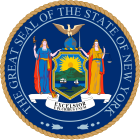
Back নিউ ইয়ার্কের প্রশাসনিক বিভাগ Bengali/Bangla División administrativa del Estado de Nueva York Spanish Liste des subdivisions administratives de l'État de New York French Pembagian administratif New York ID Podział administracyjny stanu Nowy Jork Polish Divisões administrativas do Estado de Nova Iorque Portuguese Administrative divisions of New York (state) SIMPLE Nyu-Yorkning ma'muriy bo'linmalari (davlat) UZ ניו יארק שטאט געאגראפישע אפטיילונגען YI

 |
|---|
| Part of a series on |
| Regions of New York |
|---|
 |
The administrative divisions of New York are the various units of government that provide local services in the U.S. State of New York. The state is divided into boroughs, counties, cities, towns, and villages. (The only boroughs, the five boroughs of New York City, have the same boundaries as their respective counties.) They are municipal corporations, chartered (created) by the New York State Legislature, as under the New York State Constitution the only body that can create governmental units is the state. All of them have their own governments, sometimes with no paid employees, that provide local services.[1] Centers of population that are not incorporated and have no government or local services are designated hamlets. Whether a municipality is defined as a borough, city, town, or village is determined not by population or land area, but rather on the form of government selected by the residents and approved by the New York State Legislature.[2][3][4] Each type of local government is granted specific home rule powers by the New York State Constitution.[5] There are still occasional changes as a village becomes a city, or a village dissolves (stops existing), each of which requires legislative action. New York also has various corporate entities that provide local services and have their own administrative structures (governments), such as school and fire districts.[5] These are not found in all counties.
Except for its ten Indian reservations[6] and the City of New York, every piece of land in the State is part of a city or town, which, with the exception of the city of Geneva, is a part of one and only one county.[citation needed]
As of 2009[update], New York has 62 counties[7][8] (including New York City's five boroughs), which are subdivided into 933 towns[4] and 61 cities (including Geneva in both Ontario and Seneca counties, but excluding New York City and Sherrill).[3] In total, the state has more than 3,400 active local governments and more than 4,200 taxing jurisdictions.[9][10]
- ^ Gibson, Ellen M.; Manz, William H. (2004). Gibson's New York Legal Research Guide (3rd ed.). Wm. S. Hein Publishing. pp. 257–258. ISBN 1-57588-728-2. LCCN 2004042477. OCLC 54455036.
- ^ Local Government Handbook, p. 67.
- ^ a b Local Government Handbook, p. 51.
- ^ a b Local Government Handbook, p. 60.
- ^ a b Local Government Handbook, pp. 29–37.
- ^ "Certificate of Individual Indian Exemption from State Taxes on Property or Services Delivered on a Reservation" (PDF). New York State Department of Taxation and Finance. Retrieved September 2, 2019.
- ^ Local Government Handbook, p. 39.
- ^ Local Government Handbook, pp. 68–70.
- ^ "Individual State Descriptions: 2012" (PDF). 2012 Census of Governments. United States Census Bureau. September 2013. p. 203.
- ^ Governor Eliot Spitzer (2007). "Executive Order No. 11: Establishing the New York State Commission on Local Government Efficiency and Competitiveness" (PDF). State of New York. p. 1. Archived from the original (PDF) on August 12, 2007. Retrieved 2009-04-03.